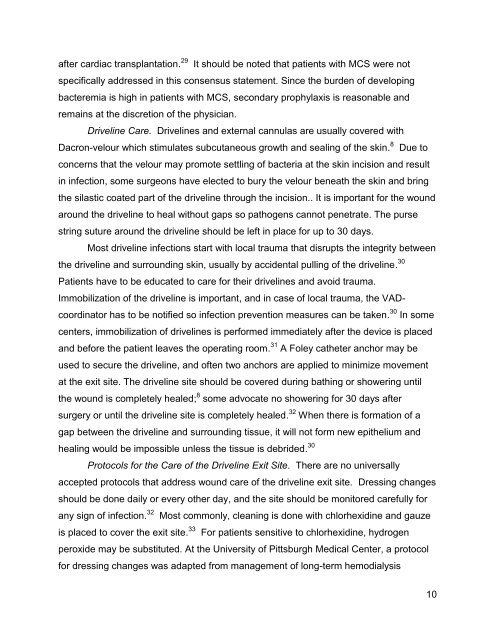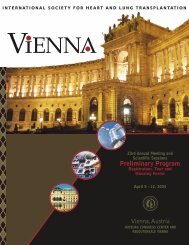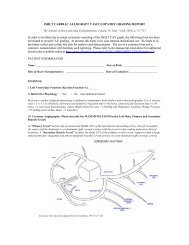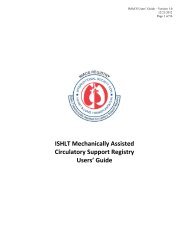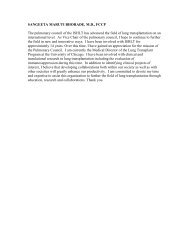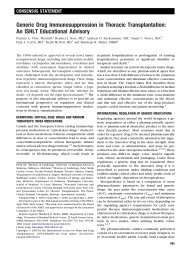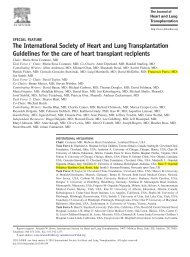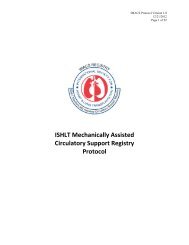Task Force 4: Inpatient Management of Patients with MCSD - The ...
Task Force 4: Inpatient Management of Patients with MCSD - The ...
Task Force 4: Inpatient Management of Patients with MCSD - The ...
You also want an ePaper? Increase the reach of your titles
YUMPU automatically turns print PDFs into web optimized ePapers that Google loves.
after cardiac transplantation. 29 It should be noted that patients <strong>with</strong> MCS were not<br />
specifically addressed in this consensus statement. Since the burden <strong>of</strong> developing<br />
bacteremia is high in patients <strong>with</strong> MCS, secondary prophylaxis is reasonable and<br />
remains at the discretion <strong>of</strong> the physician.<br />
Driveline Care. Drivelines and external cannulas are usually covered <strong>with</strong><br />
Dacron-velour which stimulates subcutaneous growth and sealing <strong>of</strong> the skin. 8 Due to<br />
concerns that the velour may promote settling <strong>of</strong> bacteria at the skin incision and result<br />
in infection, some surgeons have elected to bury the velour beneath the skin and bring<br />
the silastic coated part <strong>of</strong> the driveline through the incision.. It is important for the wound<br />
around the driveline to heal <strong>with</strong>out gaps so pathogens cannot penetrate. <strong>The</strong> purse<br />
string suture around the driveline should be left in place for up to 30 days.<br />
Most driveline infections start <strong>with</strong> local trauma that disrupts the integrity between<br />
the driveline and surrounding skin, usually by accidental pulling <strong>of</strong> the driveline. 30<br />
<strong>Patients</strong> have to be educated to care for their drivelines and avoid trauma.<br />
Immobilization <strong>of</strong> the driveline is important, and in case <strong>of</strong> local trauma, the VADcoordinator<br />
has to be notified so infection prevention measures can be taken. 30 In some<br />
centers, immobilization <strong>of</strong> drivelines is performed immediately after the device is placed<br />
and before the patient leaves the operating room. 31 A Foley catheter anchor may be<br />
used to secure the driveline, and <strong>of</strong>ten two anchors are applied to minimize movement<br />
at the exit site. <strong>The</strong> driveline site should be covered during bathing or showering until<br />
the wound is completely healed; 8 some advocate no showering for 30 days after<br />
surgery or until the driveline site is completely healed. 32 When there is formation <strong>of</strong> a<br />
gap between the driveline and surrounding tissue, it will not form new epithelium and<br />
healing would be impossible unless the tissue is debrided. 30<br />
Protocols for the Care <strong>of</strong> the Driveline Exit Site. <strong>The</strong>re are no universally<br />
accepted protocols that address wound care <strong>of</strong> the driveline exit site. Dressing changes<br />
should be done daily or every other day, and the site should be monitored carefully for<br />
any sign <strong>of</strong> infection. 32 Most commonly, cleaning is done <strong>with</strong> chlorhexidine and gauze<br />
is placed to cover the exit site. 33 For patients sensitive to chlorhexidine, hydrogen<br />
peroxide may be substituted. At the University <strong>of</strong> Pittsburgh Medical Center, a protocol<br />
for dressing changes was adapted from management <strong>of</strong> long-term hemodialysis<br />
10


